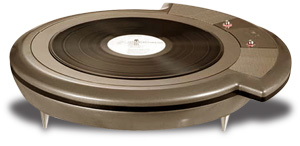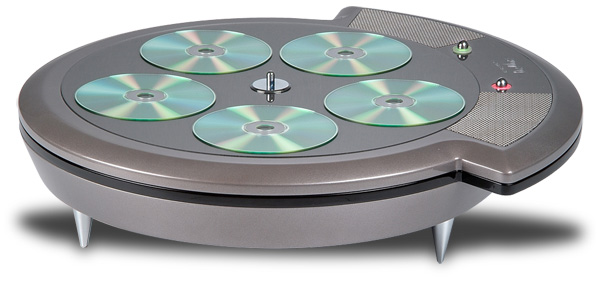![[SoundStage!]](../sslogo3.gif) The Vinyl Word The Vinyl WordBack Issue Article |
|||||||||||||||||||
February 2007 Furutech deMag LP Demagnetizer
Upon learning that Furutech’s deMag was headed my way, I wondered, as I'm sure many of you would: Why would anyone need to demagnetize LPs? Well, according to Furutech, the material added to vinyl to color it black has magnetic properties, and demagnetizing LPs makes them sound better. Given that most phono cartridges are powered by strong magnets and any outside magnetic field could interfere with the signal generated by the stylus wiggling in the groove, Furutech's reasoning seems plausible. But it gives rise to other questions: How much of a problem is the magnetic component of vinyl, and how much sonic improvement does demagnetizing your LPs make? For me, an ounce of hands-on observation is worth a pound of theory, so I was eager to answer those questions the best way possible -- through using the deMag. What it is The $1800 USD deMag looks a little like a huge turntable -- one big enough to play the 16" transcription discs once used by radio stations -- but beneath it is an electromagnet. In addition to a 17" round top surface (which is stationary, unlike a turntable's) with a spindle in the center, the unit's minimal controls are located in front. The deMag sports a glossy gray metal-flake paint job that would make most show cars envious. Furutech even includes a pair of white cotton gloves, which I guess are designed to keep you from getting fingerprints on the deMag. Be careful of these gloves; I found they were rather slippery, and it was hard to grip the deMag’s smooth surface with them on. It was nice to review a device that doesn’t have to be broken in. All I did was screw in the deMag’s feet, make space for it on my record shelf next to the VPI HW-16.5 record cleaner, and plug it in. Furutech also makes aftermarket power cords and includes an impressively large one with the deMag. The cord plugs into the front of the unit, which to my eye, pretty well ruins the aesthetics, just like plugging an amplifier’s power cord into the amp’s front panel would do. Three conical silver metallic feet support the deMag, but don’t worry -- their points are rounded so they won’t scratch your furniture. The deMag has only two buttons: On/Off and Erase. After turning the unit on, you place an LP on the spindle and press Erase. The ring around the button lights up with a green color and after about 16 seconds, it goes out, telling you the demagnetizing operation is complete. You can then flip the LP and demagnetize its other side. This operation only has to be done once. Furutech advises you to turn the deMag off when you’re not using it. What it does Have you ever tried an accessory whose effect you had to strain your ears, and perhaps your imagination, to hear? Well, the deMag isn’t one of them. The difference it made with LPs was easy to hear, if not earth-shaking. Apologies for using worn-out audio clichés, but the effect was like removing a slight veil or peering through a just-washed window. There was more detail and clarity. The tonal accuracy of instruments improved, meaning that each instrument sounded more realistic. I cued up Rachmaninov’s Symphony No.1 played by the Concertgebouw Orchestra under the leadership of Vladimir Ashkenazy from a box set called Rachmaninov Symphonies 1-3, The Bells, Orchestral Works [London R215460] first without deMag treatment and then with treatment. The sound after treatment was more vivid, and the background was quieter, which I suspect is the reason behind everything else I heard. Surface noise was not affected, unfortunately, but this LP has quiet surfaces, and I thoroughly cleaned it before the test.
At first I thought demagnetization caused a reduction in treble energy. However, on closer listening, I realized I was hearing just as much high-frequency information after demagnetization, but a previously unrealized distortion had been removed, or at least reduced, which made each LP more pleasant to listen to. This is another example of the listener not realizing a distortion was present until it had been removed. The LP of the Rachmaninov symphony was a rather thin late-production disc. I wondered if demagnetization would have a greater effect on a modern, thick LP, because it would contain considerably more vinyl and thus, to Furutech's thinking, more magnetic material. So I demagnetized Eva Cassidy’s Songbird [S&P Records S&P-501], which was pressed on 180-gram vinyl. Sure enough, there seemed to be more improvement in the sound of this thicker disc. It was as though a light layer of grunge had been cleaned away from the sound, and everything emerged from a quieter background, sounding more natural and detailed. I intended to listen to only the first cut of the LP to evaluate the deMag’s effects, but after I demagnetized it, the sound was so ravishing that I sat there, glued to my chair, until the entire side played. The sound was so much purer that I couldn’t bear to take the LP off the turntable. Again, demagnetization didn’t do anything to improve the gritty surfaces of the LP. It’s not supposed to, but I can wish, can’t I? Furutech bills the deMag as not only a treatment for LPs, but also CDs, cables, and anything else you want to demagnetize, I suppose. You can remove the spindle if it interferes with whatever you want to place on the deMag's surface. Allegedly, the paint used on the back of CDs can be magnetic, and the aluminum itself has weak magnetic properties (it’s the "Al" part of an Alnico magnet, for instance). You can demagnetize up to five CDs at a time with the deMag. The effects of demagnetizing CDs are rather similar to those with LPs. I played a new recording of Bach’s Brandenburg Concerto No.3 from the CD A Passion for Baroque [no catalog number] recorded at the Cactus Pear Music Festival. After demagnetization, the highs seemed less bright and glaring, and there was more musical detail and vividness. I even subjected my favorite CD -- La Folia, with performances by Jordi Savall and associates [AliaVox AV9805] -- to the deMag treatment, since I’m very familiar with it. On the first cut, "Folia: Rodrigo Martinez," the viola da gamba sounded more realistic after treatment. Dynamics were more precise, and bass impact was noticeably stronger.
I had never thought of demagnetizing cables; after all, most cable makers studiously avoid using any magnetic substances. However, Furutech believes there may be residual magnetic materials in a cable that would benefit from demagnetization. To evaluate the deMag’s effect on cables, I selected two pairs of Crystal Cable Piccolo interconnects. I treated one pair and left the other untreated. I then connected them between my CD player and preamp. Demagnetizing my interconnects made a very slight improvement in spaciousness and midrange purity. On "Folia: Rodrigo Martinez," the opening strikes on the cascabels (orchestral sleigh bells) sounded better defined, and it was easy to tell that the second strike is a smidgen softer. The spaciousness of the recording venue was also increased, as though the band had moved to a larger room. Jordi Savall’s viola da gamba sounded more "in the room," and the instruments’ overtones seemed more realistically balanced with their fundamentals. However, the effects of demagnetizing interconnects were much less pronounced than demagnetizing CDs and LPs. Perhaps the improvement would be more noticeable on different cables, but the Crystal Cable Piccolos were the only identical pairs of interconnects I had. Comparison To what could I compare a product like the deMag? It's not a cleaning machine or fluid; no audio product I know of operates like it. The only similar item is the Walker Audio Talisman, which also uses magnets to treat LPs and CDs but requires no power. Looking somewhat like an LP brush, the $199 Talisman is held in your hand and passed over (not in contact with) the LP or CD. One of the dealers I enjoy working with, Brian Kurtz of Sound Mind Audio in Austin, Texas, enthused about the improvements he had achieved with the Talisman, describing it as "a magic wand." I’m not quite sure how the Talisman works; for all I know, Lloyd Walker’s fertile mind has indeed produced a magic wand. To me, it’s less important to know how it works than how well it works, and the Talisman, like the deMag, does work. Just don’t bring it near your phono cartridge; the Talisman’s powerful magnetic field could demagnetize it. The Talisman’s sonic effect was similar to the deMag’s, though not identical. The deMag was better than the Talisman at cleaning up high-frequency glare. Both units made music sound more detailed, perhaps due to a quieter background. The Talisman’s effects are temporary, however, so you’ll have to treat LPs and CDs each time you play them. That’s easy to do, but not as easy as one-time treatment with the deMag. This is an important point. If it’s too much trouble to use an accessory, you might as well not buy it. My drawer full of unused audio thingamabobs woefully attests to that fact. With the deMag, all you have to do is push a couple of buttons, and you never have to repeat the treatment. It doesn’t get much easier than that! Conclusion The Furutech deMag definitely improves the sounds of LPs, CDs and, to a lesser extent, cables. Its utter simplicity means it should never become inconvenient to use. Except for the power cord protruding from the front, it also looks very attractive, and it will certainly prompt lots of questions from visitors. But the issue with the deMag, or any accessory, is its value. Is the deMag worth the $1800 it costs? For that amount of money, you could buy a new cartridge, new cables, even a new CD player. Like most things in high-end audio, the answer will depend on your system and budget. I’d have to say that with my system, the deMag easily made as much improvement as investing $1800 in some other way. However, if the deMag's price is too steep for you, the Walker Talisman is a lower-cost, lower-performance alternative. ...Vade Forrester
|
|||||||||||||||||||
|
|||||||||||||||||||
![[SoundStage!]](../sslogo3.gif) All Contents All ContentsCopyright © 2007 SoundStage! All Rights Reserved |

